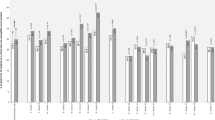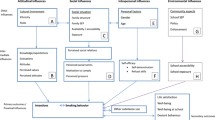Abstract
Background: We evaluated the impact of a community-based tobacco control project that was implemented in the city of Tucson, Arizona, USA, between 1996 and 2001.
Aim: The project’s goal was to reduce the prevalence of youth smoking through change in social norms at schools and in communities and workplaces. As is often the case, these community-based health promotion interventions were implemented in conjunction with other broader programmes, in this case implemented on the state level.
Method: Taking into account state level interventions as well as changes in sociodemographic and economic environment over the course of the project (e.g. increases in cigarette prices), we measure the net effect of the intervention in terms of the number of people who quit or did not initiate smoking and by the discounted life-years gained. To establish the value of investing into community-based intervention, we calculated the real discounted cost per quit and per life-year gained of $US3789 and $US3942, respectively. These compare favourably with the real cost per quit of $US4270 when implementing the 1996 US Clinical Practice Guideline for smoking cessation but exceed the real cost of $US2923 per discounted life-year gained when following the guideline.
Results: A sensitivity analysis that assumed 5% programme persistence (i.e. 5% of the programme’s impact would last forever in the absence of future funding for the programme), one-third would relapse and that one-third of those who quit may have quit smoking even without the programme, suggested a lower cost per discounted life-year saved of $US3476. The cost effectiveness of this project compares favourably with other tobacco control interventions.
Conclusion: Despite its relatively small target group, this community-based intervention was cost effective.





Similar content being viewed by others
Notes
1We assumed that the general tobacco control programmes targeted the population age 10–64 years of Arizona state or Pima County (depending on whether the programme had state- or county-level coverage) while the FCP targeted only the population age 13–18 years living in Tucson.
3The Centers for Disease Control and Prevention estimates that more than half of adult ever-smokers in the US have quit smoking.[32] Some of those who quit do so on their own but some quit as a response to tobacco control programmes. Since the proportion between these two alternatives is not clear, we assumed that two-thirds of those who quit smoking do so on their own and one-third quit as a result of tobacco control activities.
References
Centers for Disease Control and Prevention (CDC). Prevalence data. Tobacco use: nationwide, behavioral risk factor surveillance system. Atlanta (GA): CDC, 1995–1998
U.S. Department of Health and Human Services (USDHHS). The health consequences of smoking: nicotine addiction: a report of the Surgeon General. Rockville (MD): Centers for Disease Control, Office on Smoking and Health, 1988
Pierce JP, Gilpin EA, Emery LS, et al. Tobacco control in California: who’s winning the war? An evaluation of the Tobacco Control Program, 1989–1996. La Jolla (CA): University of California, San Diego, 1998
Flay BR, Koepke D, Thomson SJ, et al. Six-year follow-up of the first Waterloo school smoking prevention trial. Am J Public Health 1989; 79(10): 1371–6
Murray DM, Pirie PL, Leupker RV, et al. Five- and six-year follow-up results from four seventh-grade smoking prevention strategies. J Behav Med 1989; 12(2): 207–18
Ellickson PL, Bell RM, McGuigan K, et al. Preventing adolescent drug use: long-term results of a junior high program. Am J Public Health 1993; 83(6): 856–62
Peterson AV, Kealey KA, Mann SL, et al. Hutchinson smoking prevention project: long-term randomized trial in school-based tobacco use prevention. Results on smoking. J Natl Cancer Inst 2000; 92(24): 1979–91
Mayhew KP, Flay BR, Mott JA. Stages in the development of adolescent smoking. Drug Alcohol Depend 2000; 59 Suppl. 1: S61–81
Flay BR, Hu FB, Richardson J. Psychosocial predictors of different stages of cigarette smoking among high school students. Prev Med 1998; 27(5 Pt B): A9–18
Cummings KM, Morley CP, Horan JK, et al. Marketing to America’s youth: evidence from corporate documents. Tob Control 2002; 11 Suppl. 1: 15–7
Ling PM, Glantz SA. Using tobacco industry marketing research to design more effective tobacco-control campaigns. JAMA 2002; 287: 2983–9
Pentz MA, MacKinnon DP, Dwyer JH, et al. Longitudinal effects of the midwestern prevention project on regular and experimental smoking in adolescents. Prev Med 1989; 18: 304–21
Chen HT. Theory driven evaluations. Newbury Park (CA): Sage, 1990
Lee H, Bauer JE, MacKinnon DP, et al. Ruling out alternative explanations: assessing Full Court Press outcomes. Presented at the 2003 National Conference on Tobacco or Health; 2003 Dec 11; Boston (MA) [online]. Available from URL: http://ncth.confex.com/ncth/2003/techprogram/paper_9480.htm [Accessed 2006 Sep 10]
U.S. Department of Health and Human Services (USDHHS). Preventing tobacco use among young people: a report of the Surgeon General. Atlanta (GA): U.S. Department of Health and Human Services, Public Health Service, Centers for Disease Control and Prevention, National Center for Chronic Disease Prevention and Health Promotion, Office on Smoking and Health, 1994
Leventhal H, Fleming R, Glynn K. A cognitive-developmental approach to smoking intervention. In: Maes S, Spielberger DC, Defares PB, et al., editors. Topics in health psychology: proceedings of the first annual expert conference in health psychology. New York: John Wiley & Sons, Inc., 1988: 79–105
Palmer RF, Dwyer JH, Semmer N. A measurement model of adolescent smoking. Addict Behav 1994; 19(5): 477–89
Lynch B, Bonnie R. Growing up tobacco free: preventing nicotine addiction in children and youth. Washington, DC: National Academy Press, 1994
Crealey GE, McElnay JC, Maguire TA, et al. Costs and effects associated with a community pharmacy-based smoking-cessation programme. Pharmacoeconomics 1998; 14(3): 323–33
Drummond MF, O’Brien B, Stoddart GL, et al. Methods for the economic evaluation of health care programs. 2nd ed. New York: Oxford University Press, 1997
Levin HM, McEwan PJ. Cost-effectiveness analysis. 2nd ed. Thousand Oaks (CA): Sage Publications, 2001
U.S. Environmental Protection Agency (USEPA). Benefits and costs of the Clean Air Act 1970 to 1990. 1997 [online]. Available from URL: http://www.epa.gov/oar/sect812/ [Accessed 2006 Sep 20]
Monitoring the Future. 2003 data from in-school surveys of eighth-, tenth-, and twelfth-grade students. Table 1: long-term trends in prevalence of use of cigarettes for eighth, tenth, and twelfth graders [online]. Available from URL: http://www.monitoringthefuture.org/data/03data/pr03cigl.pdf [Accessed 2006 Aug 8]
Orzechowski W, Walker RC. The tax burden on tobacco: historical compilation. Vol. 28. Arlington (VA): Orzechowski and Walker, 2002
U.S. Department of Health and Human Services (USDHHS). Reducing tobacco use: a report of the Surgeon General. Atlanta (GA): U.S. Department of Health and Human Services, Centers for Disease Control and Prevention, National Center for Chronic Disease Prevention and Health Promotion, Office on Smoking and Health, 2000
U.S. Department of Health and Human Services (USDHHS). The health consequences of smoking: a report of the Surgeon General. Rockville (MD): U.S. Department of Health and Human Services, Public Health Service, Centers for Disease Control and Prevention, Center for Chronic Disease Prevention and Health Promotion, Office on Smoking and Health, 2004
Doll R, Peto R, Boreham J, et al. Mortality in relation to smoking: 50 years’ observations on male British doctors. BMJ 2004; 328(7455): 1519
D’Agostino RB, Kannel WB, Belanger AJ, et al. Trends in CHD and risk factors at age 55–64 in the Framingham Study. Int J Epidemiol 1989; 18(3 Suppl. 1): S67–72
Peto R, Lopez A, Boreham J, et al. Mortality from tobacco in developed countries: indirect estimation from national vital statistics. Lancet 1992; 339: 1268–78
Arias E. United States life tables, 2000. Natl Vital Stat Rep 2002; 51(3): 1–38
Centers for Disease Control and Prevention (CDC). Cigarette smoking among adults: United States, 2000. MMWR Morb Mortal Wkly Rep 2002; 51(29): 642–5
Centers for Disease Control and Prevention (CDC). State-specific prevalence of cigarette smoking and quitting among adults: United States, 2004. MMWR Morb Mortal Wkly Rep 2005 Nov 11; 54(44): 1124–7
Henriksen L, Jackson C. Anti-smoking socialization: relationship to parent and child smoking status. Health Communities 1998; 10: 87–101
Wakefield M, Chaloupka FJ, Kaufman NJ, et al. Effect of restrictions on smoking at home, at school, and in public places on teenage smoking: cross-sectional study. BMJ 2000; 321(7257): 333–7
Powell LM, Chaloupka FJ. Parents, public policy and youth smoking. J Pub Policy Manage 2004; 24(1): 93–112
Cromwell J, Bartosch WJ, Fiore MC, et al. Cost-effectiveness of the clinical practice recommendations in the AHCPR guideline for smoking cessation. JAMA 1997; 278(21): 1759–66
Elixhauser A. Costs of breast cancer and the cost-effectiveness of cancer screening. Int J Technol Assess Health Care 1991; 7(4): 604–15
White E, Urban N, Taylor V. Mammography utilization, public health impact, and cost-effectiveness in the United States. Annu Rev Public Health 1993; 14: 605–33
Jonsson B, Christiansen C, Johnell O, et al. Cost-effectiveness of fracture prevention in established osteoporosis. Scand J Rheumatol 1996; 25 Suppl. 103: 30–8; discussion 39-40
Ong M, Glantz S. Free nicotine replacement therapy programs vs implementing smoke-free workplaces: a cost-effectiveness comparison. Am J Public Health 2005; 95: 969–75
Acknowledgements
This manuscript was supported by a Robert Wood Johnson Foundation grant (Sponsor Reference #: 044749) for ‘Evaluation and Dissemination of Full Court Press Study Results’.
The authors have no conflicts of interest that are directly relevant to the content of this study.
We would like to thank our research assistant Yanjun Bao from the University of Illinois, Department of Economics.
Author information
Authors and Affiliations
Corresponding author
Rights and permissions
About this article
Cite this article
Ross, H., Powell, L.M., Bauer, J.E. et al. Community-Based Youth Tobacco Control Interventions. Appl Health Econ Health Policy 5, 167–176 (2006). https://doi.org/10.2165/00148365-200605030-00003
Published:
Issue Date:
DOI: https://doi.org/10.2165/00148365-200605030-00003




